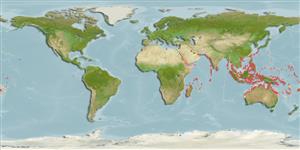Environment: milieu / climate zone / depth range / distribution range
Ecologia
marinhas; estuarina associadas(os) a recifes; intervalo de profundidade 0 - 8 m (Ref. 9710). Tropical; 30°N - 23°S, 32°E - 169°W
Indo-Pacific: Red Sea and East Africa to Samoa, north to the Ryukyu Islands, south to the Great Barrier Reef and New Caledonia.
Tamanho / Peso / Idade
Maturity: Lm ? range ? - ? cm
Max length : 14.0 cm TL macho/indeterminado; (Ref. 48636)
Descrição suscinta
Chaves de identificação | Morfologia | Morfometria
Espinhos dorsais (total) : 12; Raios dorsais (total) : 18 - 20; Espinhos anais: 2; Raios anais : 19 - 21. Numerous pale spots, dark streaks anteriorly, and several dusky bands (Ref. 4404).
Facultative air-breathing (Ref. 126274); Adults inhabit reef flats as well as shallow lagoon and seaward reefs. Also found in estuarine areas with algae-rich rubble patches on reef flats and slopes. Intertidal to a few meters depth (Ref. 48636). Usually found in areas of mixed coral, sand, and rubble (Ref. 9710). Found solitary in weedy areas on rocks and coral outcrops (Ref. 90102). Feed by scraping off algae (Ref. 1602). Oviparous. Eggs are demersal and adhesive (Ref. 205), and are attached to the substrate via a filamentous, adhesive pad or pedestal (Ref. 94114). Larvae are planktonic, often found in shallow, coastal waters (Ref. 94114). Neither fang nor venom gland is present (Ref. 57406). Also Ref. 58652.
Ciclo de vida ou comportamento de acasalamento
Maturities | Reprodução | Spawnings | Egg(s) | Fecundities | Larvas
Oviparous, distinct pairing (Ref. 205).
Randall, J.E., G.R. Allen and R.C. Steene, 1990. Fishes of the Great Barrier Reef and Coral Sea. University of Hawaii Press, Honolulu, Hawaii. 506 p. (Ref. 2334)
Status na Lista Vermelha da UICN (Ref. 130435)
Ameaça para os humanos
Harmless
Uso pelos humanos
Pescarias: pouco comercial; Aquário: Espécies comerciais
Ferramentas
Relatórios especiais
Baixar XML
Fontes da internet
Estimates based on models
Preferred temperature (Ref.
123201): 25.4 - 29.3, mean 28.5 °C (based on 2623 cells).
Índice de diversidade filogenética (Ref.
82804): PD
50 = 0.5001 [Uniqueness, from 0.5 = low to 2.0 = high].
Bayesian length-weight: a=0.00832 (0.00442 - 0.01565), b=3.02 (2.85 - 3.19), in cm total length, based on LWR estimates for this species & (Sub)family-body (Ref.
93245).
Nível Trófico (Ref.
69278): 2.0 ±0.0 se; based on diet studies.
Resiliência (Ref.
120179): Elevada, tempo mínimo de duplicação da população menor que 15 meses (Preliminary K or Fecundity.).
Fishing Vulnerability (Ref.
59153): Low vulnerability (10 of 100).
Nutrients (Ref.
124155): Calcium = 129 [58, 221] mg/100g; Iron = 0.745 [0.415, 1.336] mg/100g; Protein = 18.2 [17.0, 19.3] %; Omega3 = 0.0797 [, ] g/100g; Selenium = 20.7 [9.3, 47.0] μg/100g; VitaminA = 96.6 [25.7, 368.8] μg/100g; Zinc = 2.78 [1.80, 4.27] mg/100g (wet weight);
